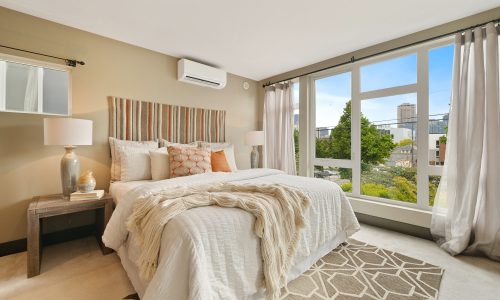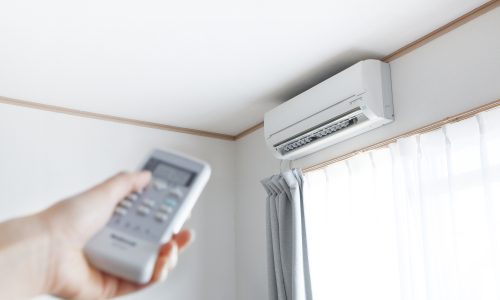Mini split systems are ductless heating and cooling systems that heat individual spaces, giving you complete control over the temperature in specific rooms of your home.
Knowing how to size a mini split system is one of the most important aspects of installing one. This article will help you better understand what goes into sizing a system, so keep reading for more information.
Of course, to ensure that your unit is properly installed, it’s always best to have a professional do the job. Improper installation can end up causing damage to your unit, so it’s recommended to get in touch with a local HVAC professional in your area.
Why is proper mini split sizing important?

Mini split systems are some of the most efficient HVAC systems out there today. However, this is only true when they’re the correct size for the space they’re in. In terms of how to properly size a mini split system, when a mini split system is either too big or too small for the space it’s in, it will work much less effectively than it should.
If the system is too big, it will begin to short cycle—i.e., the system will repeatedly turn on and off very quickly, resulting in damaged parts, uncomfortable room conditions, and wasted money.
On the flip side, if the system is too small for its designated space, it will be forced to run at a near non-stop pace, rarely (if ever) shutting down. This will burn out your system very quickly, and will result in the desired temperature that it’s trying to deliver not being achieved.
Always consult an HVAC technician for jobs such as this to ensure a correct fit and installation, as they will have the tools and knowledge to know how to install mini split system units properly.
Determining a size
The best way to determine how to size mini split systems is by doing a load calculation for the room you wish to install the unit.
To complete a basic load calculation, multiply the square footage of a room by 25 to get the BTU (British thermal units) recommendation. Here’s an example:
A 30 by 30 feet room in length and width is 900 square feet. Multiply 900 by 25 to get 22,500. The closest BTU rating to this is 24,000 BTU, so you would need to round up in this case.
Other factors to consider
When it comes to how to size a mini split system, there are many factors to consider aside from the square footage of your home. We’ve made a list of them for your convenience.
- The age of your house – Old houses can be drafty and have poor insulation
- The quality of insulation – Poor insulation leads to hot and cold air escaping more often
- Your outdoor climate – Extreme temperatures may affect the effectiveness of your unit
- Ceiling height – Ceilings over the standard 8 ft add to the size of the room, affecting the resulting load calculation
- The number of doors and windows/their draftiness – More doors and windows lead to more air escaping the house, no matter how well-sealed. This can affect the amount of heating or cooling required
- Direct sunlight – Direct sunlight affects the BTU recommendation of a room, as sunlight naturally heats it
How do mini split systems work?

When considering how to properly size a mini split system, it’s important to know how exactly these units work to make your home comfortable.
Mini splits work to transport heat energy rather than produce it via an outdoor unit with a compressor, an indoor unit with an air handler that’s mounted on a wall, and refrigeration lines.
To cool, compressed liquid refrigerant travels through the refrigeration lines from the outdoor unit to the indoor unit. The refrigerant is then converted from a liquid to a gas, cooling the unit’s coils. A blower takes in warm air, pushing it over the coils to cool it and remove any humidity.
The cool air is then released into your home, with the gaseous refrigerant afterward traveling back to be converted back into a liquid and returned to its original location.
This process repeats until your indoor climate reaches a desirable temperature.
To heat, the system works in reverse with a heating cycle.
The benefits of a mini split system
Using a mini split system in your home can reap many benefits, such as:
- Money savings – You can save up to 60% on your energy bill when compared to using central air
- Energy savings – Look for units that are Energy Star certified and check its SEER 2 energy rating
- A ductless system – This makes the unit highly efficient, simpler to install, and very quiet
- Saves on space – Units often have a small discrete design
Switching to a mini split system is great not only for your bank account, but the environment as well. However, it’s crucial to have the correct-sized system installed to avoid any issues.
Types of mini split systems
When thinking about how to size a mini split AC system, you’ll want to consider the type of unit you’re working with.
There are two main types of mini split systems:
- Ductless AC systems
- Heat pump systems
Ductless AC systems work as an air conditioning unit, only cooling the air, while the heat pump system both heats and cools the air.
Ductless AC mini split systems are used most often in areas where temperatures are frequently high, such as tropical locations, as well as places like electrical rooms, where important equipment may need to be in a cool environment.
In terms of sizing your system, both AC and heat pump systems use the same method. If you know how to size a mini split AC system, you know how to size a heat pump system as well.
Once you’ve decided on your mini split system type, you’ll need to determine how many units you’ll require.
If you only need one room heated or cooled, a single-zone system will do just fine. Single-zone systems only use one outdoor unit and one indoor unit.
They’re perfect for homes with a small basement or spare room that doesn’t get heated or cooled sufficiently. However, they cannot be converted into a multi-zone system at a later date, and a new system will have to be installed.
If more than one unit is required in your home, you will need a multi-zone system. They consist of one outdoor unit, and up to eight indoor units.
Get in touch with Autumn Air for mini split installation
Mini split systems are a cost-efficient, energy-saving way to heat and cool your home, as long as they’re sized correctly.
We hope this guide helped you better understand how to size a mini split system. If you need assistance with sizing your system and want a mini split unit installed, contact Autumn Air today!













